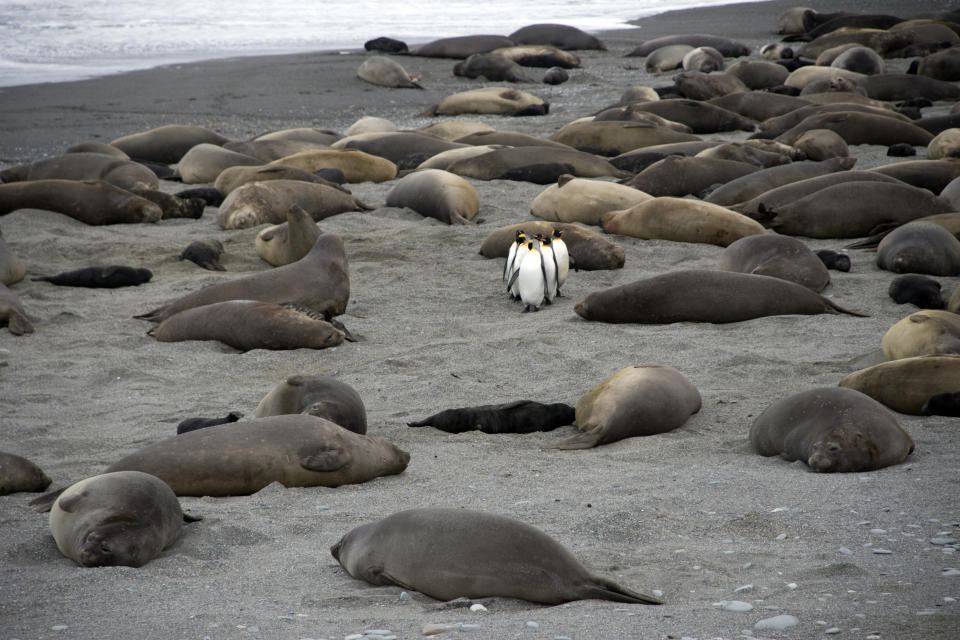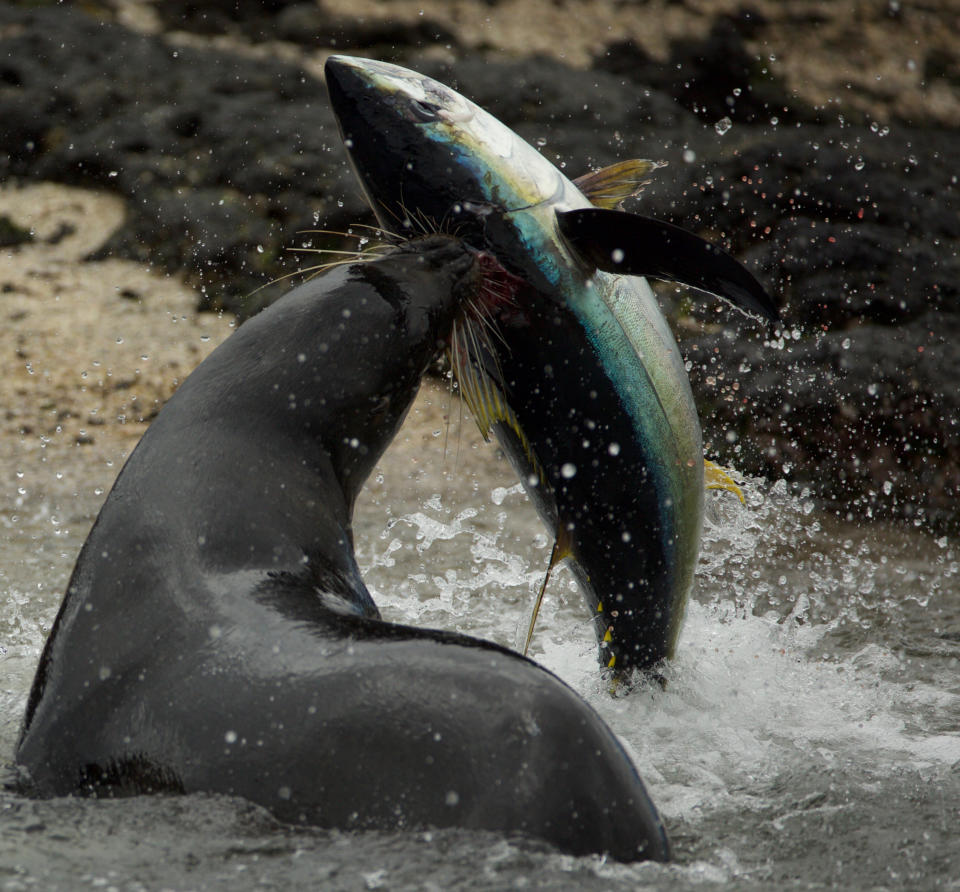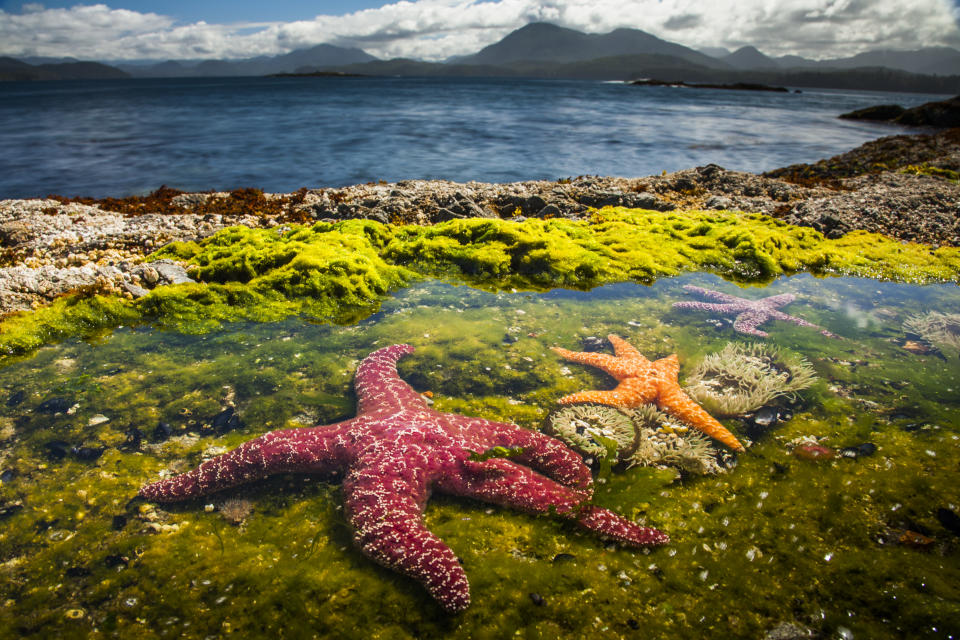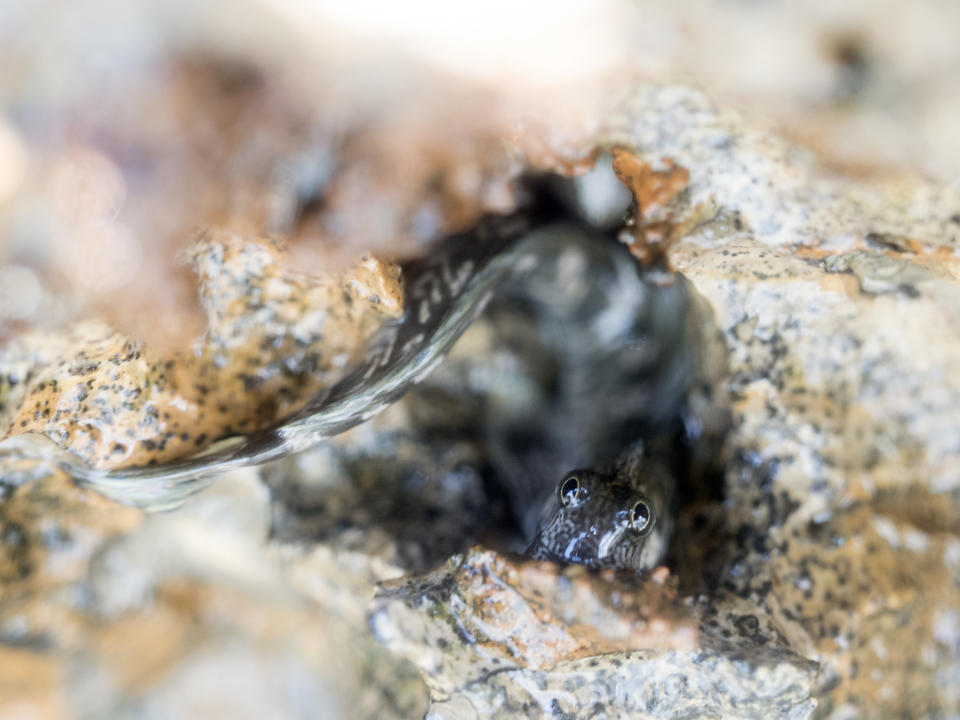'Blue Planet II': See what happens when penguins come between battling elephant seals
No other episode of Blue Planet II has more action than this Saturday’s “Coasts,” which shows the lengths to which animals go to survive the world where land and sea collide.
One memorable sequence, as seen above, follows king penguins as they tiptoe through slumbering elephant seals on the shore of St Andrews Bay in South Georgia, an island close to Antarctica. It’s breeding season for the elephant seals, which means the bulls are vying for power, and since it’s spring, hundreds of thousands of penguins are arriving en route to the colony (where 40,000 chicks await, but also, as narrator Sir David Attenborough says, “a trial of endurance” that involves shedding all their feathers and growing new ones). The penguins just need to make it through the obstacle course of elephant seals without getting caught in the testosterone crossfire.
“There’s certainly an element of Clash of the Titans with the elephant seals,” episode producer Miles Barton says of the moment conflict erupts. “We’ve seen the penguins and the elephant seals on beaches before. The key there was, we got a handheld movie camera rig so the cameraman could move in amongst the elephant seals as they moved. It was like he was the king penguin making its way up the beach, and he would have to move to the left or the right according to where the elephant seals were thrashing.”

“It’s quite a dodgy business — you’ve got to leap out of the way,” Barton says. “I’ve been on those beaches, and you do go along armed with a stick. Although a stick against a three-ton elephant seal doesn’t do much. But you feel slightly safer carrying it anyway.”
The stakes are even higher on the coast of Brazil for Sally Lightfoot crabs. Every day they wait for the tide to go out and expose their feeding grounds — algae-covered rocks 100 meters from the shore. They leap from rock to rock to get there, hoping to stay out of the water. Why? Meter-long moray eels and clever octopuses. To us it feels like the Blue Planet II equivalent of Planet Earth II‘s viral “Iguana vs. Snakes” sequence. For Barton, it’s a bit like Mission: Impossible. “Every day this wave of crabs has to march out to those rocks with the low tide. Then, when the tide comes back in again, they’ve got to repeat it all over again. There’s literally a gauntlet of moray eels and octopus in every pool. It’s amazing how some animals have to live their lives,” he says. Watch the clip above and we guarantee you’ll be shouting, “Go! Go!” at the screen. “I always like to surprise people,” Barton says. Somebody said to me, ‘I hate crabs. I’m not interested in crabs at all. But by the end of that sequence, I felt really sorry for it.’ To get people to feel empathy for a crab is a hell of a wonderful thing to achieve.”

It was a challenging shoot, though. “It was just an incredibly slippery beach. You’ve got camera equipment worth 50 grand. Half the time the cameraman had to be up to his waist in water, because everything happens literally on the tide line as the crabs move in and out. What would happen is, our local guide, Joao Paulo Krajewski, who had actually studied these crabs, would go ahead and he would just trip across the rocks no problem at all. But it was very difficult for us to keep up with him. By the time we arrived, there’d been a couple of splashes and we’d missed it. So we split into two teams,” Barton says. “It was the fast team just carrying a camera in the hand with a beanbag and then running across the rocks as quickly as possible, slam the beanbag down, slam down the camera, and just get the moment when the moray eel would leap out of the water. Then we had a bigger camera with a longer lens, and if the behavior continued, we would capture that. Sometimes we would actually have two cameras on the same event, which meant you’ve got a wide and a close-up.”
Seeing the crabs slow down, scuttle, and leap from rock to rock was actually comical at times. “Occasionally they’d fall short and land in the water. Then they just paddle frantically to get out of the water. Of course, as soon as you see one of these eels leap out of the water, you realize what the crabs are so nervous about,” he says.
What really surprised the crew, however, was that there were nearly as many octopuses as eels stalking the crabs. “The funny thing is that the octopus were so reactive to any movement above the water, a couple of times they actually grabbed hold of us around the ankles,” Barton says. “I suppose there was a shadow. But they would try to bite off a little bit more than they could chew, really.”

In terms of “sheer drama,” Barton’s pick for the must-see sequence in “Coasts” is Galapagos sea lions banding together to herd their prey — 130-pound yellowfin tuna that can easily outswim sea lions in the open sea at speeds of 40 mph — into a cove. Two years before a team was dispatched, cameraman Richard Wollocombe came into the BBC offices and told producers a fisherman’s tale: “He’d been having a drink in a bar, and there’s a bloke who says, ‘The sea lions run the tuna up onto the beach and grab them off the shoreline.’ He initially said, ‘Well, I don’t believe that.’ We said the same to [Richard],” Barton says. “Then over that period of time, we got this fisherman to go out and put out a GoPro. That took about six months to [confirm his story]. Then we took another year or so to carefully plan the shoot.”
It’s a behavior that has only been witnessed there — and it had never been filmed before. On the first trip, the Blue Planet II team saw the cooperative hunting. But it was on the second trip that they realized the best way to really capture it was from the air. “That’s when we got our drone pilot, Dan Beecham, out there, and just by hovering above you could see the strategy perfectly,” Barton says. “You could see two or three sea lions bringing a group of tuna in. They get narrower and narrower into this channel, and then nip into sections and culverts that are created by the black lava in the Galapagos. Then you actually saw that the one sea lion would hang back and block the escape route. Then, one by one, they could pick off these tuna. Sometimes they were able to grab them underwater. But every now and again the tuna panicked so much they would leap out and be flapping around on the beach. Obviously it was a complete doddle then for the sea lions just to grab them.”

For an action sequence that really pulls at the heartstrings, Blue Planet II traveled to Norway, where puffin parents take turns traveling roughly 60 miles round trip to feed their chicks. Just when they’re about home, they have to fend off “pirates” — birds, namely the Arctic skua, who want to steal the fish. It’s heartbreaking, but also like watching a dogfight in Top Gun as the puffins maneuver to shake the skuas.
“We had an amazing bird cameraman, Barrie Britton, who can follow and predict the behavior of birds. If I was standing next to him and I saw the chase, I wouldn’t know whether the skua had made contact with the puffin, or where the fish had fallen out, or anything, because it’s happening so fast. It’s only when you review [the footage] that you see all the detail,” Barton says. “You’d feel so sorry for the puffins. Initially there might be one skua, but as soon as there’s a sign of vulnerability in the puffin and it starts to go down, or drop its food, then three, four. It’s like the starfighters in Star Wars. The goodies and the baddies. They’re just being chased. It is an aerial duel. The trouble is, the poor old puffin, because he’s designed to swim underwater, he’s compromised, whereas the skuas are designed for aerobatics, and so they can twist and turn. They’re actually plucking the puffin’s feathers. They grab hold of their tails and shake them, and it’s always to shake the food out. The puffin may have been out feeding and flying for four, five, six hours. It comes back, and then it loses its food and has to go all the way out again. It’s a sad story.”

Heading to the rock pools of Canada to capture the battle between limpets (marine mollusks) and their top predators, starfish, Barton had another cinematic inspiration in mind: “I’d hoped we would get the best of Pixar,” he says, “but the great thing is, it’s all happening and it’s all real — all those creatures are that colorful.” The trick here was using time-lapse technology that could turn minutes into seconds. “You walk past a rock pool, you look in, and you think, ‘That’s quite pretty, but nothing much is happening.’ But if you take time and move it the way the animals are experiencing it, then you see it’s kind of tooth and dagger, tooth and claw down there. All these mini dramas are just happening everywhere,” Barton says. (To us, the tone then becomes more like Tim Burton’s stop-motion The Nightmare Before Christmas.)
He loved the idea that he might be able to make viewers start to think of a limpet as a hero as it fends off a starfish. “Nobody’s interested in a limpet. But when it’s kind of crawling along with its little face out, you feel sympathy for a limpet,” Barton says. “Not only do they kind of look cute but also they’ve got these cool defenses. One is a little protective shield that comes up. Who’d have thought that a limpet could deploy a [slippery] shield? The other is that it has its [friend, a scale worm] inside as a kind of guided missile that pops up from underneath the shell and gives the starfish a bite and sends him on his way.”

The last sequence we asked Barton to preview is a decidedly lighter tale. The most terrestrial fish on earth, the leaping blenny, lives on a few remote islands in the Pacific. “They’re extraordinary creatures because they have a unique form of locomotion. Every other vertebrate uses kind of the four-limb shuffle approach to traveling around. These curl their tails and flick — that’s extraordinary in itself — and they can go six body lengths,” Barton says. What’s particularly charming is that, like little birds or lizards, the males display colors to attract a mate. So they make their nest holes high up on a limestone cliff, then try to attract — and keep — the attention of females feeding on algae down by the tide zone and focused on avoiding being swept in by approaching waves.
“Anytime a wave comes in, they leap away from it. This is the other fun thing about these fish: It’s effectively a fish that’s afraid of the water. It’s just like kids on a beach. They run down toward the waves, and then they run away from them. This is what the blennies are doing,” Barton says. “But the problem for the males is, that keeps distracting the females every time they’ve kind of caught their eye. But eventually the females do head up toward the males, and they choose them. Then the males go completely demented, kind of wriggling and writhing. They’re not really designed for agile work on a rock, but they do their best. That black body with a bright orange fin really stands out. Then if she chooses, in she goes.”
Still, the courtship isn’t necessarily over. “The nice thing I’d noticed was that the females weren’t putting all their eggs in one basket. They’d go along, sometimes they’d check out that one. But then they’d pop into the guy a meter or so down the way,” Barton says. “They were hedging their bets sometimes.”
Planet Earth: Blue Planet II airs Saturdays at 9 p.m. on BBC America.
Read more from Yahoo Entertainment:
The most heartbreaking sequence in ‘Blue Planet II’: A pilot whale mourning her calf
The most terrifying sequence of ‘Blue Planet II’: The Bobbit worm
Why ‘The Deep’ episode of ‘Blue Planet II’ is the one you can’t miss
‘Blue Planet II’ premiere: Bird-eating fish and 5 more sequences you’ll be talking about


